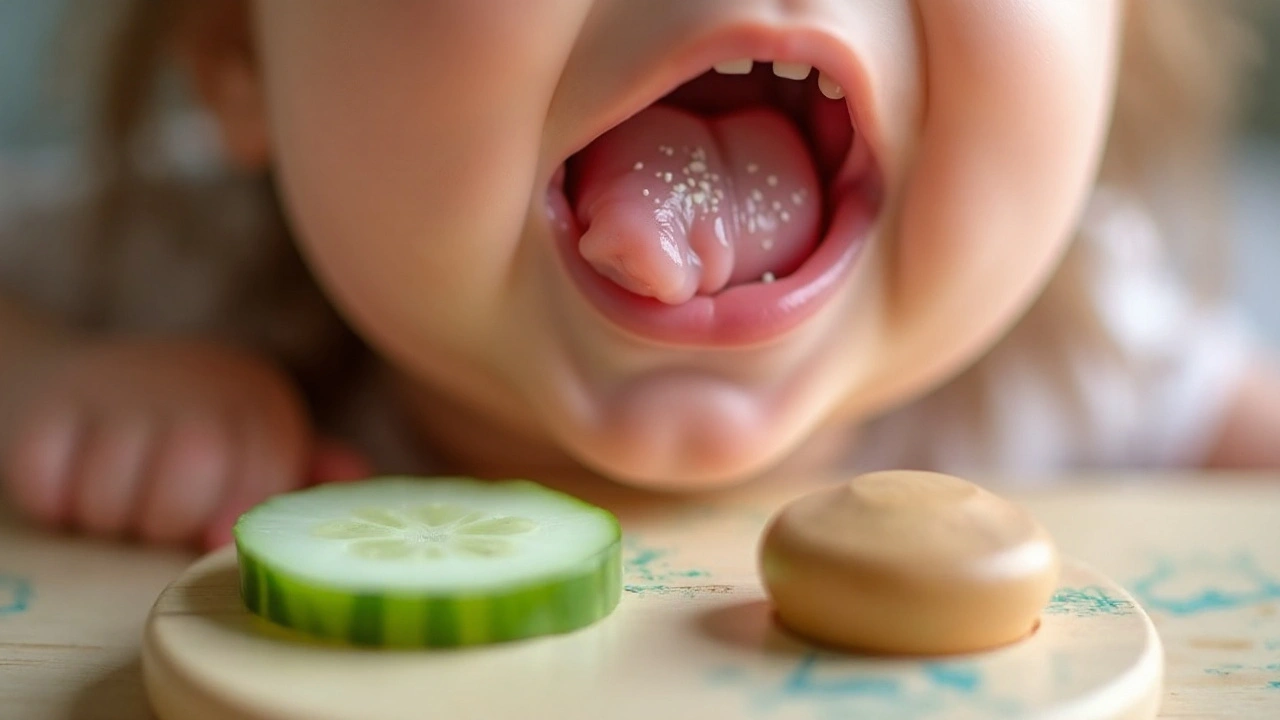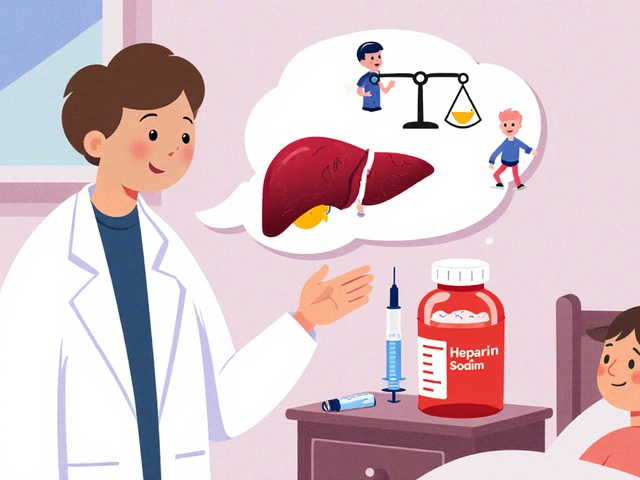Teething pain is a common source of discomfort in infants as their first teeth break through the gums. teething pain can turn a happy baby into a fussy one overnight, leaving parents scrambling for quick relief. This guide walks you through what actually happens during tooth eruption, the tell‑tale signs to watch for, and proven ways to soothe your little one without over‑reacting.
What does teething pain really mean?
When a baby’s primary (deciduous) teeth start to emerge, the underlying dental follicle pushes against the soft gingival tissue. This pressure creates inflammation, swelling, and a mild ache that babies can’t verbalise. The process begins as early as three months for some, but most infants see the first tooth between four and seven months.
Medical textbooks describe the event as "eruption of the dental organ through the alveolar ridge," but for parents it simply feels like an unexplained crankiness. Understanding the biology helps you separate normal discomfort from a sign that something else may be wrong.
Typical signs and symptoms
Every baby shows a slightly different pattern, yet a handful of clues show up repeatedly:
- Drooling is a natural response to increased oral activity and gum irritation.
- Gum swelling appears as a pink, puffy area where the tooth is pushing through
- Fussiness that peaks in the evening, often accompanied by disrupted sleep
- Chewing on toys, fingers, or anything within reach-an instinctive way to apply pressure and relieve the ache
- Mild fever (generally under 38.3°C or 101°F) that resolves quickly
If symptoms include a high fever, vomiting, diarrhoea, or a rash, the cause is likely unrelated to teething and warrants a pediatrician visit.
Why does the discomfort happen?
The eruption process can be broken down into three steps:
- The tooth’s crown forms beneath the gum.
- The dental follicle expands, stretching the overlying tissue.
- The tooth pierces the surface, exposing the enamel.
During step two, cytokines trigger inflammation, which is why the gum feels hot and swollen. This biological cascade is the same reason why adults experience sore gums after getting braces.
Key related entity: Infant is a human child from birth up to one year old. Their nervous system is still developing, so they react more intensely to any irritation, including dental pressure.
Safe home remedies to calm the ache
Before reaching for medication, try these low‑risk options that many paediatric dentists recommend:
- Cold teething ring is a silicone or rubber device chilled in the fridge (not freezer) to provide gentle numbing. Let your baby chew under supervision for a few minutes.
- Gum massage is a simple technique where a clean finger presses circularly on the swollen area, mimicking the pressure the tooth creates.
- Chamomile tea is a mild herbal solution (cooled) that can be dabbed on the gums with a clean cloth. Chamomile’s anti‑inflammatory properties are well documented in paediatric studies.
- Frozen fruit (e.g., banana slices) can be offered if your baby has started solids. The coldness soothes, and the texture provides safe chewing.
These options tackle the pain at its source-by reducing inflammation, providing counter‑pressure, or numbing the area.
When over‑the‑counter (OTC) medication makes sense
If home methods aren’t enough, a single dose of an infant‑appropriate analgesic can help. The two main choices are:
- Acetaminophen is a pain reliever and fever reducer approved for babies older than two months. Dosage is weight‑based-typically 10‑15mg per kilogram every 4‑6hours.
- Ibuprofen is a non‑steroidal anti‑inflammatory drug suitable for infants over six months. It reduces swelling as well as pain.
Never give aspirin to a child, as it’s linked to Reye’s syndrome. Always follow the label or your paediatrician’s guidance.

Red flags: when to call the pediatrician
Most teething episodes are harmless, but certain signs indicate a deeper issue:
- Fever above 38.3°C (101°F) lasting more than 24hours
- Persistent diarrhoea or vomiting
- Swollen gums that are bright red, covered in pus, or have a foul odor (possible infection)
- Refusal to eat or drink for more than a day
In such cases, schedule an appointment with your Pediatrician is a medical doctor specialising in child health and development.
Early assessment rules out ear infections, thrush, or other conditions that can mimic teething.
Debunking common myths
Parents often hear that teething causes severe diarrhoea or long‑lasting high fevers. Research from the American Academy of Paediatrics shows no causal link; these symptoms usually stem from viral illnesses that coincidentally appear during the teething window.
Another myth: “Teething gels with benzocaine are safe.” In reality, the FDA has warned against benzocaine for infants because it can cause methemoglobinemia-a dangerous blood disorder.
Stick to proven methods and avoid unregulated home‑made mixtures that lack safety data.
Developmental milestones linked to teething
Understanding the typical timeline helps you set realistic expectations:
| Tooth | Average appearance | Typical symptom severity |
|---|---|---|
| Central incisor (lower) | 6-10 | Moderate |
| Central incisor (upper) | 8-12 | Moderate |
| Lateral incisor (lower) | 10-16 | Mild |
| First molar (upper) | 13-19 | Low |
| Canine (upper) | 16-22 | Low |
| Second molar (lower) | 23-31 | Very low |
These Developmental milestones are age‑related benchmarks that indicate typical physical and cognitive growth.
Remember, each child’s schedule can vary by a few months without signifying a problem.
Comparison of common relief methods
| Method | Onset of relief | Duration | Safety rating |
|---|---|---|---|
| Cold teething ring | 5‑10min | 30‑45min | High |
| Gum massage | Immediate | 5‑15min | High |
| Chamomile dab | 10‑20min | 1‑2hrs | High (if no allergy) |
| Acetaminophen (dose) | 30‑45min | 4‑6hrs | High (weight‑based) |
| Ibuprofen (dose) | 30‑45min | 6‑8hrs | High (6mo+) |
Choosing the right tool depends on your baby’s age, the intensity of symptoms, and any existing medical conditions.
Related topics to explore next
Now that you’ve mastered teething basics, you might want to read about:
- Introducing solid foods safely after the first teeth appear
- Establishing early oral hygiene habits (toothbrush vs. gauze)
- Managing night‑time sleep regressions unrelated to teething
These subjects sit under the broader Health & Wellness category, while each article drills down into a narrower aspect of child care.

Frequently Asked Questions
How can I tell if my baby’s fever is from teething?
A mild fever (under 38.3°C) that appears alongside classic teething signs-drooling, gum swelling and night‑time fussiness-can be linked to teething. Anything higher or lasting more than a day should be checked by a pediatrician.
Is it safe to give my baby frozen carrots to chew on?
Yes, as long as the carrot is cut into a size that can’t be swallowed whole and is supervised. The cold texture eases gum pain, and the firm bite provides soothing pressure.
Can I use over‑the‑counter teething gels?
Avoid gels that contain benzocaine or lidocaine. The FDA warns they can cause methemoglobinemia in infants. Stick to cold rings, massage, or physician‑approved medication.
How long does each tooth typically stay sore?
Most babies experience heightened discomfort for 3‑5 days surrounding the actual breakthrough. The ache may dip before the next tooth starts pushing.
Should I wake my baby for feedings if they’re fussy from teething?
If the baby is still getting enough nutrition during the day, it’s fine to let them sleep. Offer a small, soothing feed if they’re genuinely hungry when they wake.




Comments
19 Comments
Gerald Nauschnegg
My kid went full feral during teething-bit through three silicone rings, screamed like a banshee at 3 a.m., and I swear the dog started avoiding the nursery. Cold washcloths were the only thing that worked. Not the gels, not the ‘natural remedies,’ just ice-cold damp cotton. And yes, I cried too.
Palanivelu Sivanathan
Teething? Ohhh, it’s not just teeth, my friend-it’s the universe whispering through gum tissue, a cosmic alignment of pressure, inflammation, and the raw, unfiltered scream of a soul learning pain for the first time!!!
And let’s be real-babies aren’t just teething… they’re evolving. The first tooth? That’s the birth of autonomy. The drool? Sacred fluid of transition.
Chamomile? Sure, but have you tried singing Gregorian chants to the gums? I did. The baby stopped crying. The cat started meditating. The neighbors called the cops.
Science doesn’t know what it’s dealing with here. We’re not talking pain-we’re talking initiation.
Also, why do we fear the cold? The earth is cold. The moon is cold. The truth is cold. Chill that ring, and chill your soul.
And yes, I’ve read every paper. I’ve cried in the pediatrician’s office. I’ve licked my kid’s gums. I’m not proud. But I’m enlightened.
Joanne Rencher
Ugh. Another ‘teething causes fever’ myth. No. Just no. Your kid has a virus. Stop blaming the teeth. I’ve seen this so many times. Pediatricians are tired of it.
And don’t even get me started on frozen bananas. You think that’s safe? What if it slips? Choking hazard. You’re lucky your kid didn’t end up in the ER.
Erik van Hees
Actually, the dental follicle doesn’t just ‘expand’-it’s a complex interplay of RANKL/OPG signaling pathways modulating osteoclast activity to resorb alveolar bone. You’re oversimplifying. Also, ibuprofen isn’t ‘suitable’ for 6-month-olds-it’s FDA-approved for 6+ months with weight-based dosing. Don’t say ‘suitable’ like it’s a recommendation from your yoga instructor.
And chamomile? Studies show negligible anti-inflammatory effect in infants. It’s placebo with a tea bag. Stick to acetaminophen if you’re gonna medicate.
Also, teething doesn’t cause diarrhea. Not even a little. Stop spreading misinformation.
Cristy Magdalena
I’m not saying this to be dramatic… but I lost three nights of sleep over one tooth. Three. Nights. And I’m still not over it. My baby’s eyes were so glassy. I thought it was dehydration. Then I felt the gum-hard as a pebble. I screamed. My husband cried. We called the pediatrician at 2 a.m. They said ‘it’s teething.’
Then the next tooth came. And the next. And the next.
I don’t sleep anymore. I just wait.
And yes, I used the cold spoon trick. And yes, I cried while holding the frozen banana. And yes, I Googled ‘is this normal’ 87 times.
Teething isn’t a phase. It’s a trauma.
Adrianna Alfano
My little one was so fussy during teething I started talking to her gums like they were little warriors. ‘You’re doing great, tiny soldier. Just push through.’
And honestly? The cold spoon thing worked like magic. I’d chill a metal spoon for 10 minutes, then let her gnaw on it. She’d just… stop. Like her whole body sighed.
I also used a clean finger to rub her gums-so gentle. It felt like I was helping her break free from something invisible.
And no, I didn’t use gels. I’ve seen too many horror stories. Benzocaine? No thanks. I’d rather hold her and sing off-key lullabies.
Teething is brutal, but it’s also beautiful. She’s growing. And I’m learning how to be softer.
Casey Lyn Keller
My kid’s first tooth came at 11 months. No fuss. No fever. No drama. Just a tiny white nub poking out like it was late to a meeting.
Meanwhile, my neighbor’s baby had a 102°F fever, diarrhea, and cried for 72 hours straight. Pediatrician said it was rotavirus. Not teething.
Stop blaming every cry on teeth. It’s lazy parenting.
Also, frozen carrots? Are you kidding? That’s a choking hazard waiting to happen. Use a mesh feeder. Or just chill a washcloth. Simple.
Jessica Ainscough
Just wanted to say thank you for this guide. I’ve been scrolling for hours looking for something that didn’t sound like a pharmaceutical ad. This felt real.
My daughter’s first tooth came at 5 months. I was terrified. Now I know it’s normal. And I know I’m not alone.
Chamomile tea on a cloth? Genius. We did that. She fell asleep for the first time in 48 hours.
You did good.
May .
Teething gels are dangerous. Don’t use them.
Sara Larson
OMG YES!! 🙌 My baby went from smiling to screaming overnight. Cold teething ring + gum massage = our holy trinity. 🤍
Also, I chilled a spoon once and it felt like magic. Like a tiny ice wand for her gums. She looked at me like I was a superhero.
And NO to benzocaine. I saw a mom use it and her kid’s lips turned blue. I still have nightmares.
You’re doing amazing. Keep going. 💪👶
Josh Bilskemper
Teething is a myth perpetuated by pediatricians who don’t want to admit they’re out of ideas. The real issue? Overstimulation. Too many toys. Too much screen time. Too many parents panicking over normal developmental noise.
Let them cry. It builds resilience. You don’t need to ‘soothe’ every whimper. The world doesn’t coddle them. Why should you?
Also, chamomile? That’s hippie nonsense. Acetaminophen is the only real solution. Everything else is performance parenting.
Storz Vonderheide
I’m a dad from the Midwest. My daughter’s first tooth came at 8 months. We used the cold washcloth trick. Didn’t know it was ‘recommended’-just did what felt right.
What I learned? Babies feel your energy. If you’re calm, they’re calmer. If you’re panicked, they panic harder.
Also, I used to think teething caused fever. Then I read a study. Turned out it was a stomach bug. We were lucky.
Thanks for the clear info. This is what parents need-not fear, not hype. Just facts.
dan koz
My son in Nigeria, he teething, he cry all day. I use cold spoon too. Also, I give him ginger root to chew. Not dangerous. Natural. My grandma do this. No problem.
But I don’t use gel. Benzocaine? No. That dangerous. I trust my hands, my spoon, my love.
Teething no be disease. It be journey.
Kevin Estrada
Okay but have you ever heard of the Teething Conspiracy? The FDA doesn’t want you to know this-gum swelling is actually a side effect of the vaccines they give at 2 months. The teeth? Totally unrelated. They’re just using teething as a cover-up.
I’ve got documents. I’ve talked to nurses. They’re scared to speak up.
And those ‘pediatric dentists’? They’re paid by the teething ring companies. Chill that ring? It’s a placebo. The real solution is magnesium oil rubbed on the gums. I swear by it.
Also, my kid’s first tooth came at 14 months. That’s late. That’s suspicious.
Katey Korzenietz
My daughter’s tooth came at 3 months. I thought it was a tumor. I called the ER. Turned out it was just… a tooth.
And yes, I used the frozen banana. And yes, she choked. Once. On a tiny piece. I did CPR. She’s fine. But I will never do it again.
Also, why is everyone so obsessed with ‘natural’ remedies? I’m not a witch. I use acetaminophen. It’s science. Deal with it.
Ethan McIvor
Teething is the first time a child experiences pain without understanding it. It’s not just physical-it’s existential. They’re learning that their body can betray them.
And yet, we rush to fix it. We numb it. We distract it. We medicate it.
What if we just… sat with it? Held them. Let them scream. Let them feel the wave without trying to stop it?
Maybe the real healing isn’t in the cold spoon. It’s in the quiet, trembling arms of a parent who doesn’t run.
Mindy Bilotta
My daughter was teething and I used the mesh feeder with frozen blueberries. She loved it. Super safe, super soothing. No choking risk.
Also, I started brushing her gums with a soft infant brush even before the tooth came. Now at 1 year, she doesn’t hate toothbrushing. Huge win.
Don’t wait for teeth to start oral care. Start now.
Michael Bene
Teething? Please. That’s just the tip of the iceberg. The real horror? When the second molar comes in at 2 years. That’s when the screaming turns into existential dread. I’ve seen moms collapse. I’ve seen dads quit their jobs.
And the myths? Oh, they’re everywhere. ‘Teething causes diarrhea’? No. ‘Frozen carrots are safe’? Are you insane? That’s a toddler-sized bullet.
But here’s the truth: nothing works. Not the rings. Not the gels. Not the chamomile. Not even the acetaminophen.
You just ride it out. And you pray.
And when they finally sleep? You cry. Not from joy. From exhaustion.
Gerald Nauschnegg
Wait, you used a mesh feeder with frozen fruit? Genius. I didn’t think of that. My kid just chewed the whole banana. I panicked. Now I’m buying those mesh bags. Thanks.
Write a comment